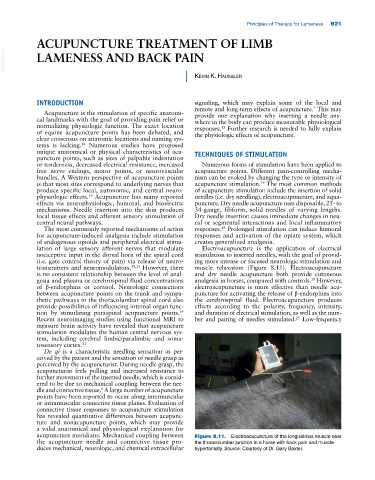Page 955 - Adams and Stashak's Lameness in Horses, 7th Edition
P. 955
Principles of Therapy for Lameness 921
ACUPUNCTURE TREATMENT OF LIMB
VetBooks.ir LAMENESS AND BACK PAIN
Kevin K. hauSSLer
INTRODUCTION signaling, which may explain some of the local and
remote and long‐term effects of acupuncture. This may
7
Acupuncture is the stimulation of specific anatomi- provide one explanation why inserting a needle any-
cal landmarks with the goal of providing pain relief or where in the body can produce measurable physiological
normalizing physiologic function. The exact location responses. Further research is needed to fully explain
13
of equine acupuncture points has been debated, and the physiologic effects of acupuncture.
clear consensus on anatomic locations and naming sys-
tems is lacking. Numerous studies have proposed
14
unique anatomical or physical characteristics of acu- TECHNIQUES OF STIMULATION
puncture points, such as sites of palpable indentation
or tenderness, decreased electrical resistance, increased Numerous forms of stimulation have been applied to
free nerve endings, motor points, or neurovascular acupuncture points. Different pain‐controlling mecha-
bundles. A Western perspective of acupuncture points nism can be evoked by changing the type or intensity of
is that most sites correspond to underlying nerves that acupuncture stimulation. The most common methods
19
produce specific local, autonomic, and central neuro- of acupuncture stimulation include the insertion of solid
physiologic effects. Acupuncture has many reported needles (i.e. dry needling), electroacupuncture, and aqua-
19
effects via neurophysiologic, humoral, and bioelectric puncture. Dry needle acupuncture uses disposable, 25‐ to
mechanisms. Needle insertion into the skin produces 34‐gauge, filiform, solid needles of varying lengths.
local tissue effects and afferent sensory stimulation of Dry needle insertion causes immediate changes in neu-
central neural pathways. ral or segmental interactions and local inflammatory
The most commonly reported mechanisms of action responses. Prolonged stimulation can induce humoral
19
for acupuncture‐induced analgesia include stimulation responses and activation of the opiate system, which
of endogenous opioids and peripheral electrical stimu- creates generalized analgesia.
lation of large sensory afferent nerves that modulate Electroacupuncture is the application of electrical
nociceptive input in the dorsal horn of the spinal cord stimulation to inserted needles, with the goal of provid-
(i.e. gate control theory of pain) via release of neuro- ing more intense or focused neurologic stimulation and
transmitters and neuromodulators. 18,25 However, there muscle relaxation (Figure 8.11). Electroacupuncture
is no consistent relationship between the level of anal- and dry needle acupuncture both provide cutaneous
gesia and plasma or cerebrospinal fluid concentrations analgesia in horses, compared with controls. However,
18
of β‐endorphins or cortisol. Neurologic connections electroacupuncture is more effective than needle acu-
between acupuncture points on the trunk and sympa- puncture for activating the release of β‐endorphins into
thetic pathways in the thoracolumbar spinal cord also the cerebrospinal fluid. Electroacupuncture produces
provide possibilities of influencing internal organ func- effects according to the polarity, frequency, intensity,
tion by stimulating paraspinal acupuncture points. and duration of electrical stimulation, as well as the num-
14
Recent neuroimaging studies using functional MRI to ber and pairing of needles stimulated. Low‐frequency
25
measure brain activity have revealed that acupuncture
stimulation modulates the human central nervous sys-
tem, including cerebral limbic/paralimbic and soma-
tosensory cortex. 27
De qi is a characteristic needling sensation as per-
ceived by the patient and the sensation of needle grasp as
perceived by the acupuncturist. During needle grasp, the
acupuncturist feels pulling and increased resistance to
further movement of the inserted needle, which is consid-
ered to be due to mechanical coupling between the nee-
dle and connective tissue. A large number of acupuncture
6
points have been reported to occur along intermuscular
or intramuscular connective tissue planes. Evaluation of
connective tissue responses to acupuncture stimulation
has revealed quantitative differences between acupunc-
ture and nonacupuncture points, which may provide
a valid anatomical and physiological explanation for
acupuncture meridians. Mechanical coupling between Figure 8.11. Electroacupuncture of the longissimus muscle near
the acupuncture needle and connective tissue pro- the thoracolumbar junction in a horse with back pain and muscle
duces mechanical, neurologic, and chemical extracellular hypertonicity. Source: Courtesy of Dr. Gary Baxter.

